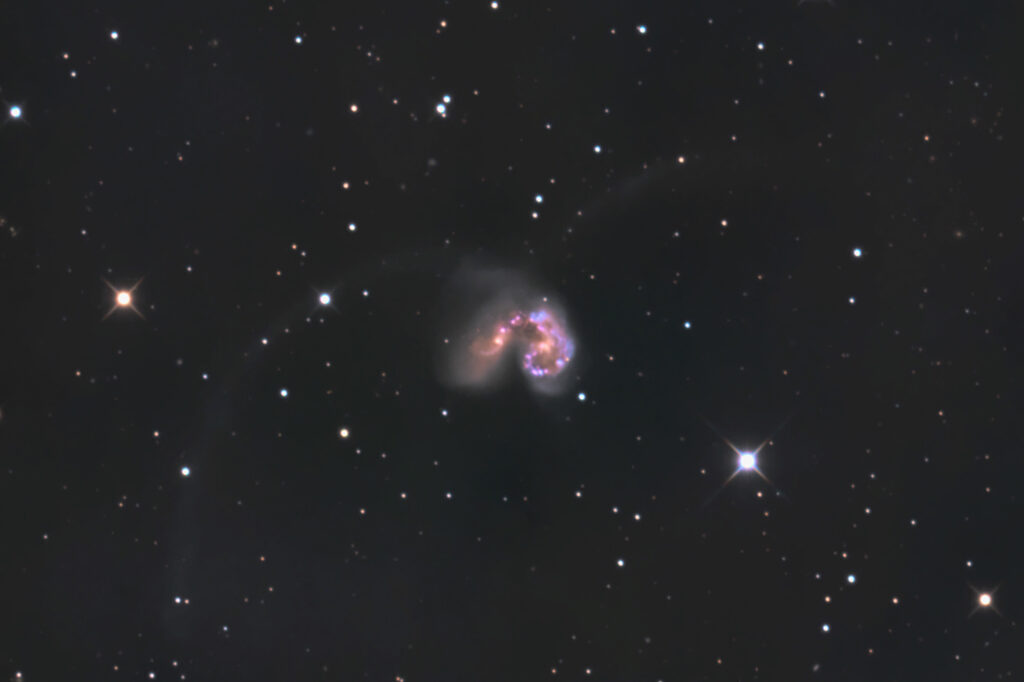
The Antennae Galaxies, NGC 4038-9 in Corvus, captured by the RC12 Astrograph in the KPO dome. LRBG image with a total integration time of 9.5 hours.
The Antennae Galaxies, also known as NGC 4038 and NGC 4039, are a pair of interacting galaxies located in the constellation Corvus, approximately 45 million light-years away from Earth. These galaxies are named for the long tidal tails of stars and gas that extend from them, resembling the antennae of an insect. The Antennae Galaxies are a prime example of a galactic merger, where two galaxies collide and merge to form a new, larger galaxy.
The interaction between the Antennae Galaxies has sparked a frenzy of star formation, leading to the creation of thousands of young, hot stars in massive star clusters. These clusters are visible as bright, blue knots scattered throughout the galaxies, contrasting with the older, redder stars that make up the galactic cores. The intense gravitational forces at play during the merger have triggered this burst of star formation, as gas and dust are compressed and heated, providing the raw materials for new stars to form.
The collision between the Antennae Galaxies has also distorted their shapes, pulling out long tidal tails of stars and gas that stretch for tens of thousands of light-years. These tidal tails are a visual reminder of the violent and chaotic nature of galactic mergers, as the two galaxies interact and reshape each other through gravitational forces. Over time, the Antennae Galaxies will continue to merge and eventually form a single, larger galaxy as the process of galactic cannibalism unfolds.
In addition to the spectacular star formation and tidal tails, the Antennae Galaxies are also home to a number of supernova explosions. These powerful events mark the deaths of massive stars, which explode in brilliant bursts of light and energy, briefly outshining their host galaxies. Studying these supernovae can provide valuable insights into the life cycles of stars and the processes that drive galaxy evolution.
The Antennae Galaxies serve as a captivating example of the dynamic and ever-changing nature of the universe. Their ongoing merger and transformation offer a glimpse into the violent processes that shape galaxies and drive the formation of new stars. Observing and studying the Antennae Galaxies provides astronomers with a unique opportunity to explore the complexities of galactic interactions and the impact they have on the evolution of the cosmos.
In conclusion, the Antennae Galaxies are a stunning pair of interacting galaxies that showcase the beauty and power of cosmic collisions. Their intricate structures, intense star formation, and dramatic tidal tails make them a favorite target for astronomers and a source of fascination for all who gaze upon them. The Antennae Galaxies stand as a testament to the relentless forces of gravity and the transformative nature of galactic mergers in shaping the vast and awe-inspiring universe we inhabit.
Image Info
- Imaged from the Kissimmee Park Observatory, in Saint Cloud, Florida
- Camera : ZWO ASI2600MM Pro
- Scope: Orion RC-12 Ritchey-Chretien Astrograph, 2450mm fl, F/8
- Mount: iOptron CEM-120
- Luminance: 53 subframes of 300s = 265 min integration
- Red: 23 subframes of 300s = 115 min integration
- Green: 20 subframes of 300s = 100 min integration
- Blue: 18 subframes of 300s = 90 min integration
- Total integration time: 570 min = 9.5 hours.
- Captured via ASIAir Pro automation
- Optical tracking via ASIAir automation via the ASI174mm Pro guide camera
- Separate channels stacked and SHO4 integrated in Astro Pixel Processor
- Image run through Super DeNoising
- Final processing in Aperture
